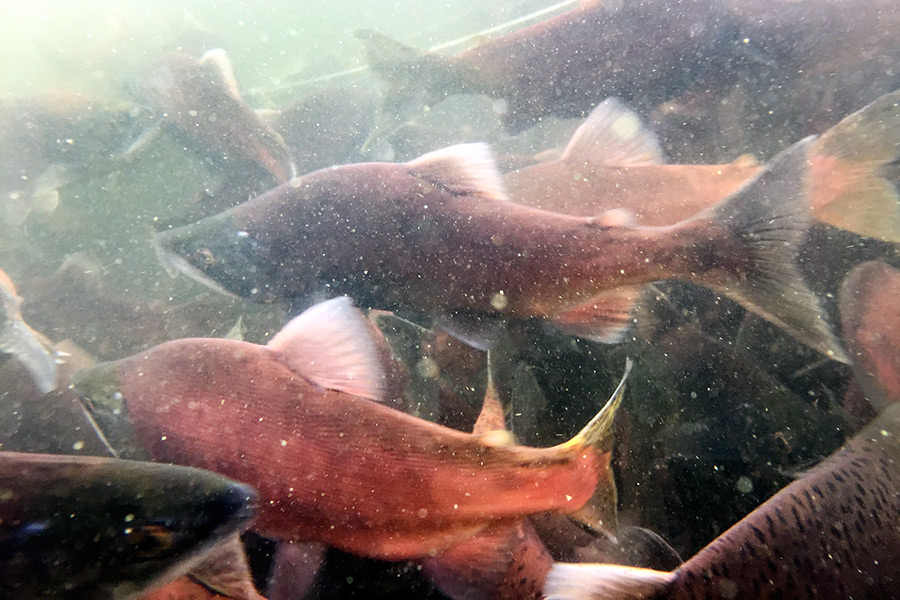LAKE MARY RONAN — Come late October, the silver shimmer of kokanee salmon flickering in this closed-basin lake flashes red, the autumnal sign of spawning season.
Although they are not native to this 1,500-acre body of water, these scarlet jewels have become treasured across Montana. This robust population of kokanee creates a prized fishery for sportsmen while also supplementing the entire state.
In recent weeks, Montana Fish, Wildlife and Parks staff have conducted the annual harvest, corralling thousands of salmon in a large offshore net and collecting roughly 2 million eggs.
Mark Kornick, manager of the Flathead Lake Salmon Hatchery, led a small team of staff and volunteers who tackled the repetitious yet vital project.
One by one, Tricia Cycz, a fish culturist with FWP, and Gar Holmes, a longtime volunteer, grabbed the slippery fish and squeezed out eggs — roughly 150 from each female — and semen from the red, hooked-jaw males before returning them to the water.
From there, the buckets of orange eggs are transferred to the hatchery off U.S. Highway 93 in Somers, as well as to the satellite Rose Creek Hatchery near Bigfork, where they will fertilize over winter. By springtime, the hatchery will be home to thousands of salmon that are then distributed to lakes across Montana.
With the help of Lake Mary Ronan, the hatcheries are the lone source of kokanee eggs in Montana. Although the threat of pike increased with last year’s discovery of the predator fish, the lake’s salmon population remains healthy and abundant, Kornick said.
“There have not been any issues in recent years,” he said. “We see small fluctuations year to year, but the numbers are good.”
That’s welcome news for local and statewide anglers.
“We stock a lot of kokanee, and when they grow, they are very popular,” Mark Deleray, regional fisheries manager for FWP, said. “It’s a tremendously important portion of our program because we are able to stock hundreds of lakes in the region and provide a really strong and popular fishing opportunity.”
Hatcheries have played a key role in Montana’s outdoor heritage for over a century.
By the late 19th century, as settlers flooded into Montana chasing gold and other treasures, a collective sentiment had formed around the importance of protecting the region’s rich fish populations. Laws were created to govern the ways that fish could be caught and to defend against over-consumption. Another valuable resource emerged in 1896, when the federal government built Montana’s first fish hatchery, located on Bridger Creek near Bozeman. A few years later, in 1901, the Montana Department of Fish and Game was organized, and in 1907, the first state-run fish hatchery was approved, located in Anaconda.
In 1912, the state acquired land near Flathead Lake from W.M. Cramer and built a hatchery that became the second state-run source for supplying young fish to Montana’s lakes and streams. The original land consisted of 625 feet of lake frontage and a total of 2.1 acres. The site was to be a hatchery and residence for the superintendent of the state fish hatcheries. A residence was built, but the superintendent never ended up living in it. State managers began stocking various species of fish at the hatchery in 1913.
Today, the hatchery has the capacity to handle over 8 million eggs. Over 1 million fingerling salmon and grayling are raised and distributed each year.
In 1970, the state purchased 20 acres near Bigfork for a satellite operation. The state-of-the-art Rose Creek Hatchery, fully completed in 2011, rears kokanee salmon, arctic grayling and westslope cutthroat trout.
Montana now has 12 hatcheries across the state.
“The hatcheries are really important to those native fish conservation efforts and when it comes to creating recreation opportunities in lakes where there’s just not the reproductive potential to have wild, self-sustaining fisheries,” Deleray said.
